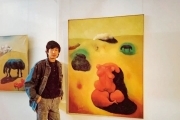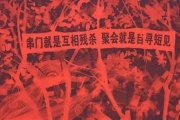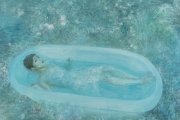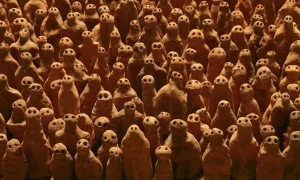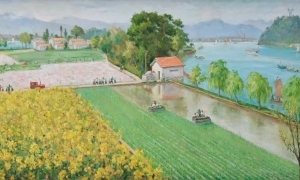LV Peng
ZHOU Chunya is one of the earliest painters who gave up literary themes. The year 1980 is a year in which the “Scar Art” of Sichuan Fine Arts Institute became widely known in China. When others were using brushes to describe historical scars, ZHOU Chunya had his first visit to Hongyuan county of Tibetan. No one told him why he had to go to that sunny place, but it was imaginable that the dark history and grey city will drive an eargerly changing and spiritually rich painter to his place of hope. “In my first visit there, I found the charm of color from the skin color of Tibetan, from the sky and moutains distance away.” It was a kind of rebellion from the painter himself and the reality was that he had no chance or possibility to understand things of the impressionism. He once wrote in his Memorabilia: in 1979, “The library of Sichuan Fine Arts Institute bought a painting album of French Impressionism and put it in a glass desk for the visitors to read, one page per day. ZHANG Xiaogang and I always went there to appreciatte and copy the works from the masters of the impressionism.” We began to knew Monet, Cezanne and Pissarro, then we knew Matisse, Van Gogh and Picasso. In 1981, ZHOU Chunya and ZHANG Xiaogang went to visit similarly colorful Ruoergei Grassland together, where he had his life paitnings for several times. Now, we clearly understand the true reasons for him to choose the Tibetan life and sceneries on the grassland. For him, the themes expressed in the “Scar” Art were not all the art was about, but contrarily the rudeness and the boldness and colorfulness of the life in Tibet was everything that attracted him directly. Therefore, his works of A New Generation of the Tibetan came out in 1980, which was natural of course. Just as the artist himself said: When I left the grassland where I experienced my life, many specific things became fade from my memory, only left with stong and heavy colors on the grassland, simplehearted and wild images of the Tibetan, as well as these colors and image lines…In my first visit to the grassland, the five kids later I had in my oil painting works A New Generation of the Tibetan impressed me most…I did not purposely pursue certain kind of style, even if my current paintings are still considered with some personal peculiarity, it is just to be different from others. The highlighted lines and natural images in my pictures also show some kind of deformation, which was the inspiration I had from the objects and the need of composition, not out of the motivation to actively represent. I hoped I can touch the nature naively and purely, in a way a firstborn seeing the world.
A New Generation of the Tibetan and a series of works on Tibetan life on the grassland by ZHOU Chunya, both show a kind of spiritual trend recognized by Chinese artists at that time, the most outstanding characteristic was that the artist actively combine his art or heart demand with a kind of themes with human kindness and humanitarian ideals. Artists began to consciously study and use also various kinds of brand-new and subjective way of object description. Large amounts of western modernism artists and genres were introduced in China, which brought chances and sources of inspirations for artists during a period of time. It undoubtedly enhanced the status and importance of the subjective art language in the explorations of the artists. Then in 1984, he again used the wild and bold block brushworks in his works Ruoergei in the Sunshine created to strongly represent the sunshine in the altiplano. But in the contrary, in A Family, his tone was quiet and steady. So later, he changed his bright and vivid tone and easy emotions.
In 1985 and 1986, ZHOU Chunya’s description of Tibetan life and sceneries changed. The works in this period of time overcome some visions and feelings as a “visitor” in A New Generation of the Tibetan and other works, gained a more substantial, more mature understanding of the nature and himself, and found a kind of relevant language way. The mystery feelings and beams were all things that ZHOU Chunya trying to pursue and render out. In The Tower under the Moonlight, people disappeared from the image and a kind of clear rational control seemed to simplify the stylistic composition of the objects in the image. The forms of the objects in the image seemed to be coincident with Cezanne’s conclusion that the nature was composed of forms like cylinders and cones. The strong light and shadow effect reminded people of the street scenes and squares in Rome or Turin as described by Tshirikov.
ZHOU Chunya’s painting stages and language transition show a great diversity. To great extent, the art of the painter known earliy by people in the period of “Scar art” was right the symbol of the modernism paintings to maintain vitality in its renaissance in the 80s and transition in the 90s.
At the beginning of 1989, I came back to Chengdu from Germany. There was still no airconditioner in cold Chengdu at that time and I was back to my studio parted for 3 years in my fashional coat. My hometown also changed greatly, and the most impressive change was the sanitary towel of women, which three years ago, was still a piece of huge and thick bathroom tissue. But in Germany, small pieces of water-sipping Menstruation tampons were found in rest rooms. In Germany, I ever sit in a car at 200 k.p.h. running on the freeway invented by Hilter while it would take me five to six hours even to Leshan. In Germany, I saw the peak period of the New Expressionism and I graduated from Kunsthochschule Kassel of Germany, and there was the most avant-garde Kassel Documen-ta in the world, in which I first saw the performance art, installation art and political art represented in images, while before my study abroad, the art of our country was mainly politically serving for the government. In Germany, I first wore my western suit with tie to enjoy the concern by Berlin Philharmonic Orchestra, while one of the reason to push me back our country was an ancient Chinese song At a Border-fortress.
The above were basic situations before ZHOU Chunya’s
return to China’s mainland; the understanding of the society and life changes; the understanding of the contemporary European art and the traction of accepting the demand of the heart.
In China in early 1990s, the disappointment at the politics and social atmosphere resulted from the Commodity Economy made artists seemingly think that they could use the way lacking of technologies---nearly common ways of ads---to express their bored and absurd hearts. The paintality was an interest and a way grown out of the romannticism, which had been the basic guide line of artists for long. However, the social status in the 90s made the painter lose any of his previous aesthetic preference and painting itself became the expression of concepts or “ideas”, at least, the paintality was commonly avoided. Therefore, it was hard for ZHOU Chunya, a painter having already accepted the influence from Baselitz, Punk and Kiefer, to be a member of popular art. The rational and dramatic declaration against the reality and the politics---either implicative or overly dramatic---was not the power of ZHOU Chunya, he could only follow his own will to study on the arts by Bada Shanren, HUANG Binhong, etc. But this attitude declaration was different from that of popular art, also far away from the aftereffect of the modernism. Until the mid 90s, there was still no artist in the contemporary art circles to move their eyes to the depth of the history, and even WANG Guangyi only briefly reviewed the recent history through the use of images from the period of “Cultural Revolution”.
Just like his absence from the creation of “scar” themes of others, ZHOU Chunya absent again from the trend of realism and political pop art, but found his own possibility for art in his feelings, not just the sense. He chose “stones”, as a result of his reference to painting albums of the ancient painters. “I don’t know why mountains and stones have always been an ever-lasting theme in traditional Chinese painting, maybe because they are the symbols of the nature. the power and integrity of mountains and stones enabled the painters to express adequately their spirits, as well as showing their painting techniques. ” When in a foreign coutry, a man would easily feel what the history is, for a man disconnected with the land where he grew up would have the feelings of being broken away from the history. The benefit was that he could review the past. ZHOU Chunya felt what he needed deep in his heart among the chords of Zheng. Those classic and simple rhythms were just like trees and grass in the yard waving in the wind, soft but tough, appearing to be beautiful and moony in the dusk. It was just what he needed in his heart. In traditional paintings, stones have the functions of symbolization and metaphor. For example, stones can be accompanied by flowers and grass to construct the nature of nobleness and faithfulness, the meaning of which is just in accordance with the demand of the ancient literators, but also has no conflict with the heart demand of ZHOU Chunya. Moreover, as mountains and stones is “abbreviation” of the nature. The description of mountains and stones became that of the nature and the ancient. It was also the native likeness that pushed ZHOU Chunya in endless painting the stones he undertstood. He tried to combine the brushworks of the expressionism and traditional way of writing. He liked HUANG Binhong because this traditionalist tried to rescue the weak traditional painting through the ways to express black, dense, thick and heavy. HUANG Binhong did not believe that Chinese painting and calligraphy willl lose their lives under the impact of the western painting. There was no much difference between ZHOU Chunya and HUANG Binhong’s attitudes, only that the former cared nothing for the materials and tools, but only the energy as a unique civilization. ZHOU Chunya naturally regard it as a kind of flowing thing, and a couple of years later, ZHOU Chunya still says: “The real valuable traditions are things in progressive tense. Traditions becoming traditional attributes to the confirmation of the past by people nowadays, attributes to our collective memories and understandings.” The statement nearly says that it is just the constant memories and understandings that continue the traditions, otherwise, the traditions are nothing. In this stand we know why ZHOU Chunya’s theme the same as the ancients became so licentious and temerarious.
I painted on stones not for considerations of graphics or signs, merely for interests. I liked forms of stones by ancient literators, but was not content with the overly mild and introverted personality. So I thought about a kind of risky attempt---rely this kind of elegant form to communicate a kind of violent even erotic meaning.
Actually, the literary traditions people have been used to lack no misery, braveness and romantic loves in its elegance, nobleness and simplicity. ZHOU Chunya’s feelings can find their resonance from the works Suzhou Gardens by the artist HONG Lei in late 90s. Both of their works show the artists’ sentimental attachment and mercy to the traditional civilization. Why was it not good for the ancients to paint stones? ZHOU Chunya re-explained the meaning of stones in his familiar way, he recalled the history of stones, studied the fate of stones and finally changed the single symbolization of stones:
When I was painting my “Mountains and Stones”, I was researching the landscape paintings by those literators. I did not try to understand them from the material attributes and graphic forms as those traditional Chinese painters did, but tried to find something strange but surprising according to my own presentation attempt. I spent a lot time on textures and sense of reality, forced myself crazily almost to capture and taste those visual factors hiddened in the natural attributes of the stones, enhanced and enlarged those things. However, the visual presentation was originally the content without need to make too much explanation and extension, which was more surprising and shocking than the stones we saw and understood from concepts and means.
ZHOU Chunya’s “stone” have experienced different changes. The painter was early familiar with the way of the new expressionism and what he had to do then was that the German way should be transformed into his own way through the temperament of Chinese people. In the process of this transformation, the ancients---including painters like DONG Qichang and WANG Yuanqi---will inevitably had a subtle influence on the painter. Initially it was the expressive composite, strong brushworks and blocks that enabled us to see the his understanding of HUANG Binhong; During this period of time, some occassional lines and brushworks could remind us of the brushworks of Bada Shanren or the literators. Later, “stone” took on a clear volume and structure and until his finishing of “Stones of Taihu Lake” in 2000, ZHOU Chunya realized the natural and sorrowful life and history---such attitude, any different from the ancients like NI Zan or JIAN Jiang? Westerners pay attention to see the existence of the God from a particle of sand on the ground, ZHOU Chunya believed that it was only from a stone that we ould see the continuing of the civilization, just as he states: “If a green leaf is enough to represent the spring, then I will abandon the whole forest without hesitation!” Spiritually, this grandiloquence was still something of the literators.
ZHOU Chunya is a painter earliest to use expressive language aimlessly. But different from those expressionism painters in the 90s, he avoided the anxious pathological characteristics at the beginning of his expressive language use and more tended to French Expressionism---Fauvism---not German Expressionism. He lived in Germany for quite a long period of time (1986-1989), though he kept visiting art galleries and museums and understanding the history of German art, the New Expressionism again strongly influenced his understanding of expressing spirits. Then through his temperament, he avoided the influences of early Expressionism but accepted the New Expressionism in contemporary European art.
However, when he was back to the motherland, when he was appreciating the ancient paintings, and sinking into the rhythms of Zheng and Gu Qin, history again called up him, or say there was still a demand of another expressionism in his heart---the one from SU Shi, WANG Meng, NI Zan, DONG Qichang, SHI Tao, Bada Shanren and HUANG Binhong. Therefore, ZHOU Chunya inherited the spiritual attitudes of the predecessors in ways and techniques not concepts and words. Under the influences of western New Expressionism, ZHOU Chunya abandoned “weakness” and “inertia” while among ancient works of Chinese, he maintained “mildness” and “introversion”. The western color enabled him to show the sadness of history while the traditional tips nourished his changes of expressing language. Generally, the temperament adsorbed various influences so effectively that ZHOU Chunya once signed: thanks to the “Expressionism”, thanks to the “literators’ paintings”. It was a change of the cultural concept unnoted by people in the 90s, with the feature that everything can be used and adsorbed. In ZHOU Chunya’s art, such change are perceptual and instinctive, which provided the painter a more direct way to understand the history and be distinctive from those artists simply “peculating”. Until the late 90s and the first few years of the new century, people found that a large amount of contemporary artists began to seek conceptual break-through from the traditions and the history.
In 1994, a German shepherd dog appeared in ZHOU Chunya’s family and the painter named it “Heigen”. The image of “Heigen” began to appear on the canvas constantly and ZHOU Chunya’s intimacy with “Heigen” made the representation of “Heigen” endlessly until the death of “Heigen” in 1999. Originally “Heigen”was a specific life being in which the painter used a careful way of painting. Even in 1997 he painted “Heigen” in green color and the trace was still quite careful. After“Heigen” guiding the painter’s emotions died, ZHOU Chunya could only understand the life being ever vigorous through his own memory. The specific object was far away and the painter could let it painting go randomly to memorize the lost “Heigen”with a hasty trace---it seemed that memorization was not able to endure careful and delicate portraying, the color of green still existed but became a symbol with abstract way of painting and randomicity, completely not physical assumption of “Green Dog”, which, to the painter, was only an experimental resource of painting art, not a representation resource:
The form of “green dog” adobted the formal characteristics of flowers and birds paintings by literators in brushworks while sculpturing, achieving the commensuration between sculpture and flowers and birds paintings. It was easy for me to associate the dimension and space feeling of sculpture when I was viewing the flowers and birds paintings by Ba Da Shan-ren. Meanwhile, I could still feel the depth of sculpture from the minus space of that huge area. So I took a risk to enlarge the visual attribution hiddened behind and got fantastic results.
After the year 2000, ZHOU Chunya often smoothed from the hasty “Green Dog” to the abstract. In various abstract works, we can see something reflecting the early “stones”, “human body” and “sceneries”, and the painter again came to his time to experiment and change. Gradually, pink peachblossom appeared one by one. Initially (in 1997), peachblossom only served as a contrast and foil of the subject demi-wolf with its mildness and beauty, which the painter was quite fascinated with. People with knowledge of traditional Chinese culture can understand that flowers have an erotic symbolizing effect. But the way ZHOU Chunya adopted to narrate an erotic story was to reflect the rigid object through “mildness” to deliver an erotic and gorgeous attraction. “Red Human Body” was the erotic subject occassionally appeared in ZHOU Chunya’s paintings. But in order to maximize the charming ardor color, ZHOU Chunya again employed the temperament of the ancients: imply violence in mildness, or highlighted the purpose mildness in violence---violence is always against mildness. In the painter’s own words: “From demi-wolf to peachblossom, a transformation again happened from ‘violence’ to ‘mildness’.” While actually, the painter borrowed the traditional delicate attitude: try as much “mildness” as possible to enhance the beautiful “violence”.
I have a piece of calligraphic couplet by the late sage of late Qing Dynasty GONG Qinggao of my hometown. “Trim the eyebrows on the lake with mountains distance away, face becomes like a small peachblossom before the wind. ” The language is distinguished and romantic, revealing the delicacy and elegance of the ancient literator, containing as well the feelings of spring, ambiguous but with a bit sense of love. Too beautiful to feel good, but hard to control. I am more direct and frank and have no euphemistical way of expressing as ancient literators did, what I describe is just “beautiy and love”---inherent desires of human---flowery peachblossom and a man and a woman with illicit sexual relations are strangely juxtaposed together to melt the barriers between the human and the nature, also blur the boundary between evil and morality, indulging a sincere and instinctive fantasy in a flowing colored emotion, releasing and exploding absolutely the natural attribute of human in a significant scene---mildly but violently.
“The series of Peachblossom” was created simultaneously with “Green Dog” and “Human Body”. In the new century, ZHOU Chunya’s “Peachblossom” shows a characteristic as follows: form an interaction between borrowing of concepts and maintaining of paintality.
We don’t know whether the westerners can really understand the meaing of “Be colorful as peaches and plums where is ulcerated”, but they surely understand the source of the scenery in the works.
Psychologically speaking, any behaviour has its motivation. Even though we don’t know what the painters experience and encounter everyday, we can still see from their works that the particularity of the language is still the life of the painting. Anxiety, sadness, fear and harmfulness never happen without reason, but painters can only use the final pictures to prove the pecularity of the changes in his heart. Therefore, to eliminate “meanings”and refuse “explanations” may not be regarded as a kind of deceiving only after the eyes are able to judge the forming of new pictures. Philosophic concepts can only start the programming of painters, while the pictures themselves are the final basis to judge the concepts. When it came to the late 90s, personal images started from Cynicism and Political Pop were quite splendid, and it was gradually easy for people to keep memories of the signs of painters. This phenomena pushed people begin to understand the importance of “trademark” or “brand”. Uniqueness and repetitiveness are both artistic, especially when photos and TV images became effective tools, paintality was reduced to the lowest level to eliminate the trace. Under such a circumstance, it was possible for people to again pay attention to the interest of the picture, not the originality of the concept. Certainly, when commercial power stopped the creativity and sensibility of painters, we could also find the emergence of open paintality.
In fact, the freedom of the concept and the interest of the painting push forward the stretching of the “new painting”. In the turning of the centuries, ZHOU Chunya’s art become a case of summarizing new painting. ZHOU Chunya’s painting has experienced influences from Van Gogh, Modigliani, Tshirikov and German painters mentioned above, such a spiritual hisotry coincide with the transforming course of China’s contemporary art from the 80s to the 90s. He accepts the taste of the times, he is eager to understand the history of western cultures, but he also knows that his “Chinese stone” has its undividable natural environment and he must locate himself in the soil deeply missed and loved by all educated peope, that is to say, he doesn’t think there is a contemporary standard of cosmopolitism, even there is, it is just the personality shown from representing the differencees of various civilizations. Therefore, he spends more time and practices in understanding the meanings of civilization and tradition. The only different between him and those new literator painters using traditional tools and materials is that ZHOU Chunya only admits that there is a civilization and a tradition to be re-understood, explained, tasted and memorized through new tools and new materials. Meanwhile, the painter also understands quite well that there is no invariable personality. The personality is growing out of changes. All concepts---revolutionary and improved, traditional and modern, contemporary and globalized---may cover the evolution of the civilization itself, but the instinct will tell what exactly should be the art attitude today.
I believe that history is an evolving process full of personalities. Its real charm is not those “inevitable rules”we concluded afterwards, but something seemingly occasional, which brought us more sensations and became more important to our life than the inevitable rules had. If you wonder why those things seemingly occasional became so important, then you will be extremely fascinated with history. Only in questioning like that, the traditions can become charming and only such traditions are of artistic quality.
This kind of savvy ZHOU Chunya expressed also exists in minds of many outstanding artists, whose understandings of art history and art future compose a valuable heritage of art concepts of the 20th century.
【编辑:虹汐】


